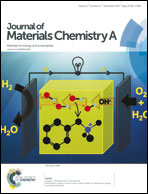Improved cut-resistance of Kevlar® using controlled interface reactions during atomic layer deposition of ultrathin (<50 Å) inorganic coatings†
Abstract
Conformal atomic layer deposition (ALD) of Al2O3 and TiO2 thin films on Kevlar®, poly(p-phenylene terephthalamide) (PPTA) fibers at 50 and 100 °C affects the fiber cut resistance. Systematic studies of ALD coatings between 10 to 400 Å thick formed at 50 and 100 °C revealed excellent conformality, and trends in cutting performance depended on materials and process details. A 50 Å/50 Å TiO2/Al2O3 bilayer formed at 50 °C increased cut resistance of PPTA by 30% compared to untreated fiber materials. In situ infrared analysis shows that trimethylaluminum (TMA) Al2O3 precursor reacts sub-surface with PPTA and tends to degraded mechanical performance. The TiCl4 TiO2 precursor reacts to form a barrier that limits TMA/PPTA interactions, allowing a harder Al2O3 layer to form on top of TiO2. The thin ALD coatings do not substantially affect durability, flexibility, or weight of the PPTA, making ALD a potentially viable means to enhance the protective properties of Kevlar and other polymer fiber systems.


 Please wait while we load your content...
Please wait while we load your content...